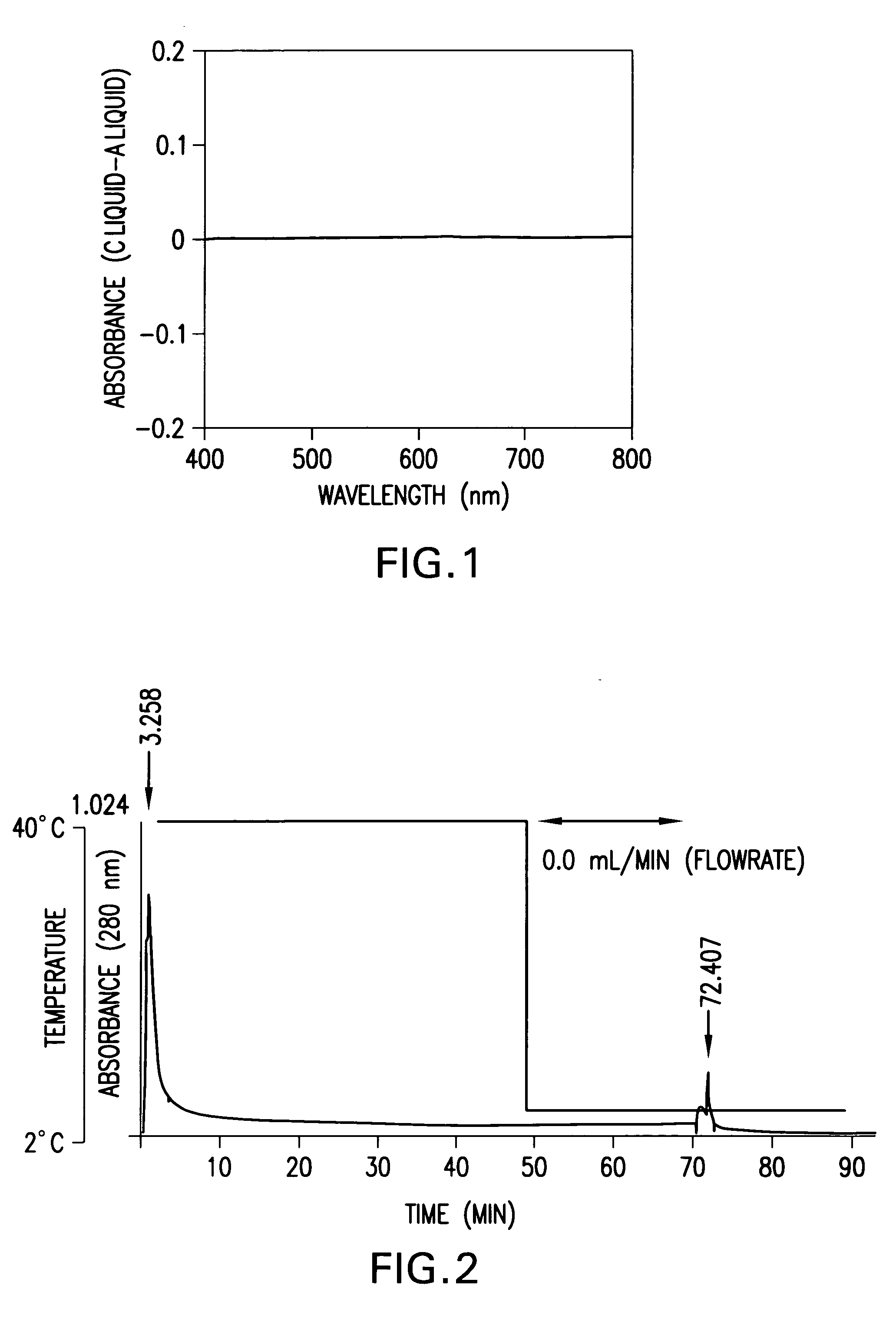Novel material for use in separation and separating method using the same
- Summary
- Abstract
- Description
- Claims
- Application Information
AI Technical Summary
Benefits of technology
Problems solved by technology
Method used
Image
Examples
example 1
[0057] Cibacron Blue was dissolved in a 67 mM phosphoric acid buffer solution having a pH of 7.0 such that the concentration came to 9.95 .mu.M to prepare a solution A. A poly(N-isopropyl acrylamide) having a number average molecular weight of 4,700 was dissolved in a 67 mM phosphoric acid buffer solution having a pH of 7.0 such that the concentration came to 10.5 mM that was used to prepare a solution B. The difference in the spectrum of solution A relative to a solution C obtained by adding 5 .mu.L of solution B to 2 mL of solution A was found to determine whether there is an affinity between Cibacron Blue and the poly(isopropyl acrylamide) or not. FIG. 1 shows the difference in the spectrum. From 400 nm to 800 nm, no difference in the spectrum between solution C and solution A was found and thus, it became clear that there is no affinity between Cibacron Blue and the poly(N-isopropyl acrylamide).
example 2
[0058] Bovine serum albumin (BSA) used as the target substance and Cibacron Blue (CB) as the molecule interacting with the target substance were made up with a heat-responsive polymer and the change in interaction with the target substance by a temperature stimulus was evaluated by a chromatographic technique. As a result, it was confirmed that the interaction changed by a temperature change to dissociate the CB molecular from BSA.
[0059] 1. Synthesis of Polymer
[0060] (1-1-a) Synthesis of Poly(N-isopropyl Acrylamide / N-acryloxy-succini-mide) [Hereinafter Referred to as Poly(IPAAm-co-ASI)] Having Terminal Carboxyl Group
[0061] In a polymerization tube were charged 15 g of N-isopropyl acrylamide, 1.24 g of N-acryloxy succinimide as the monomer having a functional group, 0.28 g of mercaptopropionic acid (MPA) as the chain transfer agent, 82 mg of 2,2-azobisisobutyronitrile (AIBN) as the polymerization initiator and 500 ml of tetrahydrofuran (THF), and the polymerization tube with the cock...
example 3
[0083] With the use of the technique described in Example 2, three types of carriers were synthesized by fixing a CB-poly(N-isopropyl acrylamide) composite material having a different molecular weight as shown in Table 1 on to silica gel. These three types carriers were packed in a stainless steel column, respectively, to prepare three types of columns. With the use of these three types of columns, with respect to pullulans having a different molecular weight as the target substances, calibration curves at 40.degree. C. and 10.degree. C. were measured (FIG. 4). It was suggested from the change in volume of elution by a temperature change that the change in the structure of the composite material was caused on the surface of the carrier. It was also found that by varying the molecular weight of the composite material to be fixed on to the carrier, different calibration curves could be obtained and thus, depending on the size of molecular weight of a stimulus-responsive polymer, the m...
PUM
| Property | Measurement | Unit |
|---|---|---|
| Temperature | aaaaa | aaaaa |
| Mass | aaaaa | aaaaa |
| Temperature | aaaaa | aaaaa |
Abstract
Description
Claims
Application Information
 Login to View More
Login to View More - R&D
- Intellectual Property
- Life Sciences
- Materials
- Tech Scout
- Unparalleled Data Quality
- Higher Quality Content
- 60% Fewer Hallucinations
Browse by: Latest US Patents, China's latest patents, Technical Efficacy Thesaurus, Application Domain, Technology Topic, Popular Technical Reports.
© 2025 PatSnap. All rights reserved.Legal|Privacy policy|Modern Slavery Act Transparency Statement|Sitemap|About US| Contact US: help@patsnap.com



